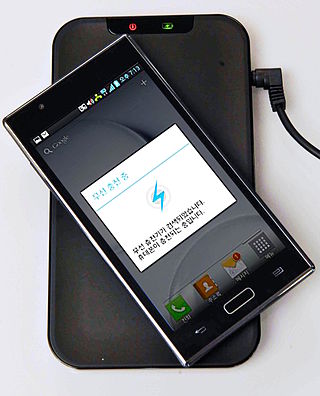
A space elevator, also referred to as a space bridge, star ladder, and orbital lift, is a proposed type of planet-to-space transportation system, often depicted in science fiction. The main component would be a cable anchored to the surface and extending into space. An Earth-based space elevator cannot be constructed with a tall tower supported from below due to its immense weight—instead, it would consist of a cable with one end attached to the surface near the equator and the other end attached to a counterweight in space beyond geostationary orbit. The competing forces of gravity, which is stronger at the lower end, and the upward centrifugal force, which is stronger at the upper end, would result in the cable being held up, under tension, and stationary over a single position on Earth. With the tether deployed, climbers (crawlers) could repeatedly climb up and down the tether by mechanical means, releasing their cargo to and from orbit. The design would permit vehicles to travel directly between a planetary surface, such as the Earth's, and orbit, without the use of large rockets.

The Ansari X Prize was a space competition in which the X Prize Foundation offered a US$10,000,000 prize for the first non-government organization to launch a reusable crewed spacecraft into space twice within two weeks. It was modeled after early 20th-century aviation prizes, and aimed to spur development of low-cost spaceflight.

Zylon (IUPAC name: poly(p-phenylene-2,6-benzobisoxazole)) is a trademarked name for a range of thermoset liquid-crystalline polyoxazole. This synthetic polymer material was invented and developed by SRI International in the 1980s and manufactured by Toyobo. In generic usage, the fiber is referred to as PBO.
The Centennial Challenges are NASA space competition inducement prize contests for non-government-funded technological achievements by American teams.

Wireless power transfer (WPT), wireless power transmission, wireless energy transmission (WET), or electromagnetic power transfer is the transmission of electrical energy without wires as a physical link. In a wireless power transmission system, an electrically powered transmitter device generates a time-varying electromagnetic field that transmits power across space to a receiver device; the receiver device extracts power from the field and supplies it to an electrical load. The technology of wireless power transmission can eliminate the use of the wires and batteries, thereby increasing the mobility, convenience, and safety of an electronic device for all users. Wireless power transfer is useful to power electrical devices where interconnecting wires are inconvenient, hazardous, or are not possible.

A lunar space elevator or lunar spacelift is a proposed transportation system for moving a mechanical climbing vehicle up and down a ribbon-shaped tethered cable that is set between the surface of the Moon "at the bottom" and a docking port suspended tens of thousands of kilometers above in space at the top.
The International Space Development Conference (ISDC) is the annual conference of the National Space Society (NSS). Now in its 41st year, these conferences connect the general public and the NSS membership with leaders of contemporary space efforts. The ISDC provides a nexus for industry, government, scientists, advocates, and the public to meet and discuss the latest issues in space technology, science, policy, commerce, medicine, exploration, settlement and much more. Winners of the annual NASA space settlement Contest annually attend the conference, with several interesting activities and programs. With National Space Society's major goal being to accelerate the process of space exploration and development they also foster astronautics for students by encouraging them and getting them involved.

Jordin T. Kare was a physicist and aerospace engineer who researched laser propulsion. He was responsible for Mockingbird, a conceptual design for an extremely small reusable launch vehicle, and was involved in the Clementine lunar mapping mission. Kare also conceived the SailBeam interstellar propulsion technique. In the science fiction fan community, he was a composer, performer and recording artist of filk music.

The Northrop Grumman Lunar Lander Challenge (NG-LLC) was a competition funded by NASA's Centennial Challenges program. The competition offered a series of prizes for teams that launch a vertical takeoff/vertical landing (VTVL) rocket that achieved the total delta-v needed for a vehicle to move between the surface of the Moon and its orbit. The multi-level competition was conducted by the X PRIZE Foundation, with sponsorship from the Northrop Grumman Corporation who ran the ongoing competition. The prize purses were paid by NASA. It was held annually at the X PRIZE Cup, making its debut at the 2006 Wirefly X PRIZE Cup in October, 2006, until 2009 when the prize purse was awarded to Masten Space Systems and Armadillo Aerospace.

The X Prize Cup is a two-day air and space exposition which was the result of a partnership between the X Prize Foundation and the State of New Mexico that began in 2004 when the Ansari X-Prize was held. This led to plans to build the world's first true rocket festival. Three X-Prize Cups have been held: in 2005, 2006 and 2007. Each X Prize Cup hosts different events and demonstrations, such as rocket-powered bicycles, rocket jet packs; but particularly notable are the Lunar Lander Challenge and the Space Elevator Games. 85,000 visitors attended the 2007 X Prize Cup. Although there was no X Prize Cup in 2009, there was a Lunar Lander Challenge.

Space-based solar power is the concept of collecting solar power in outer space with solar power satellites (SPS) and distributing it to Earth. Its advantages include a higher collection of energy due to the lack of reflection and absorption by the atmosphere, the possibility of very little night, and a better ability to orient to face the Sun. Space-based solar power systems convert sunlight to some other form of energy which can be transmitted through the atmosphere to receivers on the Earth's surface.

May 20, 2021 KC Space Pirates won one of 4 $50,000 second place prizes in phase 1 of NASA's Watts on the Moon Challenge.
A space competition is an inducement prize contest offering a prize to be given to the first competitor who demonstrates a space vehicle, or a space exploration apparatus, which meets a set of pre-established criteria. It spurs pioneering development in private spaceflight.

Non-rocket spacelaunch refers to theoretical concepts for launch into space where much of the speed and altitude needed to achieve orbit is provided by a propulsion technique that is not subject to the limits of the rocket equation. Although all space launches to date have been rockets, a number of alternatives to rockets have been proposed. In some systems, such as a combination launch system, skyhook, rocket sled launch, rockoon, or air launch, a portion of the total delta-v may be provided, either directly or indirectly, by using rocket propulsion.
There are risks associated with never-done-before technologies like the construction and operation of a space elevator. A space elevator would present a navigational hazard, both to aircraft and spacecraft. Aircraft could be dealt with by means of simple air-traffic control restrictions. Impacts by space objects such as meteoroids, satellites and micrometeorites pose a more difficult problem for construction and operation of a space elevator.
Three basic approaches for constructing a space elevator have been proposed: First, using in-space resources to manufacture the whole cable in space. Second, launching and deploying a first seed cable and successively reinforcing the seed cable by additional cables, transported by climbers. Third, spooling two cables down and then connecting the ends, forming a loop.
PowerLight Technologies is an American engineering firm providing power transmission via lasers. Its primary products are power-over-fiber which transmits energy in the form of laser light through an optic fiber, and "laser power beaming" in which the laser energy is transmitted through free space.

Space tethers are long cables which can be used for propulsion, momentum exchange, stabilization and attitude control, or maintaining the relative positions of the components of a large dispersed satellite/spacecraft sensor system. Depending on the mission objectives and altitude, spaceflight using this form of spacecraft propulsion is theorized to be significantly less expensive than spaceflight using rocket engines.
A space elevator is a theoretical system using a super-strong ribbon going from the surface of the Earth to a point beyond Geosynchronous orbit. The center of gravity of the ribbon would be exactly in geosynchronous orbit, so that the ribbon would always stay above the anchor point. Vehicles would climb the ribbon powered by a beam of energy projected from the surface of the Earth. Building a space elevator requires materials and techniques that do not currently exist. A variety of Space Elevator competitions have been held in order to stimulate the development of such materials and techniques.
The Scientific Workgroup for Rocketry and Spaceflight (WARR) is a scientific workgroup situated at Technical University of Munich, composed mainly of its students. It was founded by students in 1962 with the goal to compensate for the lack of a chair for space technology at the university at the time. Since the establishment of such a chair in 1966, the group has conducted practical projects, starting with the first successful development and of a hybrid rocket in Germany. One rocket of this type was launched in 1972, another is on permanent display at Deutsches Museum. WARR has attained some public attention by for its projects in space elevator competitions, small satellites interstellar spaceflight concepts, and for winning all SpaceX Hyperloop pod competitions.















